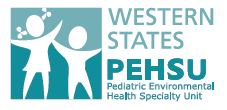The Western States Pediatric Environmental Health Specialty Unit (WS PEHSU) is one of 10 regional federally funded clinical and educational centers. We provide expert clinical and public health evaluations of pregnant people, children and communities with suspected environmental health problems or concerns. In addition, PEHSUs are a source of medical information and advice on environmental conditions that influence the health of pregnant people and children.
PEHSUs are academically based, typically at university medical centers, and are located across the United States, Canada, and Mexico. These PEHSUs form a network that is capable of responding to requests for information throughout North America and offer advice on prevention, diagnosis, management, and treatment of environmentally-related reproductive and pediatric health effects.
We are located at the University of California, San Francisco, but we have regional consultants in other geographic areas served by our PEHSU. Our program serves Arizona, California, Hawaii, Nevada, the Pacific Islands, and Tribal Nations.
The PEHSUs are administered by the American Academy of Pediatrics. More information on the PEHSU national program can be found on the National PEHSU website.
Mission
The mission of the PEHSU program is to improve reproductive and children’s health by leading the integration of environmental health into clinical care and public health while supporting communities to address historical injustices and ongoing environmental racism and address the existential threat of climate change.
Vision
Healthy Environments For All Children – Powered By PEHSU
Values
Our goal is to provide services with integrity that are:
- High quality
- Reliable
- Professional
- Ethical
- Respectful
- Objective
More information on the Pediatric Environmental Health Specialty Units is available here.
Social and Environmental Justice – The Western States PEHSU recognizes that racism is one of many toxic environmental exposures that communities of color face. Social and chemical environments can interact to impact children’s health. We commit to continuing to educate the public and healthcare providers on toxic exposures of all kinds-including racism-and fight for environmental justice.
Our Team
Our team includes Pediatricians, Pediatric Clinical Toxicologists, Occupational & Environmental Medicine Physicians, Nurses and Industrial Hygienists and Public Health experts.
Our Partners
- California Poison Control System
- UCSF Department of Pediatrics
- Center for Occupational and Environmental Health at Berkeley, Davis, & UCSF
- UCSF Occupational and Environmental Medicine Program
- Center for Integrative Research on Childhood Leukemia and the Environment*
*The PEHSU work with CIRCLE is supported by NIEHS grant 1P01ES018172 and US EPA grant RD83451101 for the Center for Integrative Research on Childhood Leukemia and the Environment at the University of California, Berkeley, Catherine Metayer, PI.
Acknowledgement: The Western States Pediatric Environmental Health Specialty Unit (WSPEHSU) is supported by the American Academy of Pediatrics (AAP) and funded (in part) by the cooperative agreement FAIN: NU61TS000296 with the Centers for Disease Control and Prevention/Agency for Toxic Substances and Disease Registry (CDC/ATSDR). The U.S. Environmental Protection Agency (EPA) supports the WSPEHSU by providing partial funding to CDC/ATSDR through Inter-Agency Agreement number DW-75-95877701. The content on this website has not been formally disseminated by CDC/ATSDR or the EPA and should not be construed to represent any agency determination or policy. Use of trade names that may be mentioned is for identification only and does not imply endorsement by the CDC/ATSDR or EPA.
The contents of this site are for informational purposes only. No content is intended to be a substitute for professional medical advice, diagnosis, or treatment. Always seek the advice of a physician or other qualified health care professional with any questions you may have regarding any medical condition. Never disregard or delay in seeking medical advice based upon something that you have read on this site. If you think you may have a medical emergency, call 911 or a qualified health care professional. Reliance on any information provided on this site is solely at your own risk.

